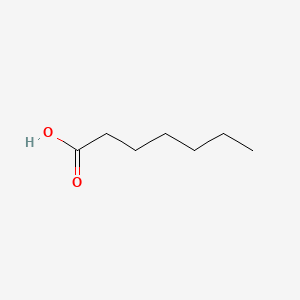| MeSH term | MeSH ID | Detail |
|---|---|---|
| Mitochondrial Diseases | D028361 | 25 associated lipids |
| Olfaction Disorders | D000857 | 17 associated lipids |
| Byssinosis | D002095 | 11 associated lipids |
HEPTANOIC ACID
HEPTANOIC ACID is a lipid of Fatty Acyls (FA) class. Heptanoic acid is associated with abnormalities such as Dehydration. The involved functions are known as Process, Anabolism, inhibitors, Oxidation and fatty acid oxidation. The related lipids are Heptanoates and undecanoic acid.
Cross Reference
Introduction
To understand associated biological information of HEPTANOIC ACID, we collected biological information of abnormalities, associated pathways, cellular/molecular locations, biological functions, related genes/proteins, lipids and common seen animal/experimental models with organized paragraphs from literatures.
What diseases are associated with HEPTANOIC ACID?
HEPTANOIC ACID is suspected in Dehydration and other diseases in descending order of the highest number of associated sentences.
Related references are mostly published in these journals:
| Disease | Cross reference | Weighted score | Related literature |
|---|
Possible diseases from mapped MeSH terms on references
We collected disease MeSH terms mapped to the references associated with HEPTANOIC ACID
PubChem Associated disorders and diseases
What pathways are associated with HEPTANOIC ACID
There are no associated biomedical information in the current reference collection.
PubChem Biomolecular Interactions and Pathways
Link to PubChem Biomolecular Interactions and PathwaysWhat cellular locations are associated with HEPTANOIC ACID?
There are no associated biomedical information in the current reference collection.
What functions are associated with HEPTANOIC ACID?
Related references are published most in these journals:
| Function | Cross reference | Weighted score | Related literatures |
|---|
What lipids are associated with HEPTANOIC ACID?
Related references are published most in these journals:
| Lipid concept | Cross reference | Weighted score | Related literatures |
|---|
What genes are associated with HEPTANOIC ACID?
There are no associated biomedical information in the current reference collection.
What common seen animal models are associated with HEPTANOIC ACID?
There are no associated biomedical information in the current reference collection.
NCBI Entrez Crosslinks
All references with HEPTANOIC ACID
Download all related citations| Authors | Title | Published | Journal | PubMed Link |
|---|---|---|---|---|
| Cometto-Muñiz JE and Abraham MH | Structure-activity relationships on the odor detectability of homologous carboxylic acids by humans. | 2010 | Exp Brain Res | pmid:20931179 |
| Di Lorenzo R and Brogli A | Profile of olanzapine long-acting injection for the maintenance treatment of adult patients with schizophrenia. | 2010 | Neuropsychiatr Dis Treat | pmid:20856920 |
| Mizunami M et al. | Alarm pheromone processing in the ant brain: an evolutionary perspective. | 2010 | Front Behav Neurosci | pmid:20676235 |
| Thomeer M et al. | Clinical use of biomarkers of survival in pulmonary fibrosis. | 2010 | Respir. Res. | pmid:20584284 |
| Zhang S et al. | Functional synchronization of biological rhythms in a tritrophic system. | 2010 | PLoS ONE | pmid:20552008 |
| Eggink M et al. | Targeted LC-MS derivatization for aldehydes and carboxylic acids with a new derivatization agent 4-APEBA. | 2010 | Anal Bioanal Chem | pmid:20238107 |
| Okumu FO et al. | Development and field evaluation of a synthetic mosquito lure that is more attractive than humans. | 2010 | PLoS ONE | pmid:20126628 |
| Neumann S et al. | A small molecule inverse agonist for the human thyroid-stimulating hormone receptor. | 2010 | Endocrinology | pmid:20427476 |
| Deng S et al. | Interrelations between C4 ketogenesis, C5 ketogenesis, and anaplerosis in the perfused rat liver. | 2009 | J. Biol. Chem. | pmid:19666922 |
| Gunschera J et al. | Surface-catalysed reactions on pollutant-removing building products for indoor use. | 2009 | Chemosphere | pmid:19181362 |
| Ding D et al. | Yeast bioassay for identification of inositol depleting compounds. | 2009 | World J. Biol. Psychiatry | pmid:18979283 |
| Reyes-Moreno M et al. | Synthesis and anabolic/androgenic evaluation of novel 9alpha-fluorosteroids. | 2009 | Eur J Med Chem | pmid:19615789 |
| Fuerst M et al. | Articular cartilage mineralization in osteoarthritis of the hip. | 2009 | BMC Musculoskelet Disord | pmid:20038300 |
| Citrome L | Patient perspectives in the development and use of long-acting antipsychotics in schizophrenia: focus on olanzapine long-acting injection. | 2009 | Patient Prefer Adherence | pmid:20016798 |
| de Jesus MJ et al. | Packages of care for schizophrenia in low- and middle-income countries. | 2009 | PLoS Med. | pmid:19841735 |
| Bassil N et al. | The benefits and risks of testosterone replacement therapy: a review. | 2009 | Ther Clin Risk Manag | pmid:19707253 |
| Smallegange RC et al. | The effect of aliphatic carboxylic acids on olfaction-based host-seeking of the malaria mosquito Anopheles gambiae sensu stricto. | 2009 | J. Chem. Ecol. | pmid:19626371 |
| Yarali A et al. | Odour intensity learning in fruit flies. | 2009 | Proc. Biol. Sci. | pmid:19586944 |
| Selcho M et al. | The role of dopamine in Drosophila larval classical olfactory conditioning. | 2009 | PLoS ONE | pmid:19521527 |
| Amorim EA et al. | Effect of cholesterol or cholesteryl conjugates on the cryosurvival of bull sperm. | 2009 | Cryobiology | pmid:19159623 |
